OnePlus 6T Review : Clawing Its Way To The Top
- Ideal software: Only helpful mods made to Android
- Battery lasts all day, easily
- Display is bright and colorful, size is ideal
- Notch is least obtrusive notch in the industry
- OnePlus-made cases are top-notch: Red silicone case shown
- Lacks headphone jack, provided dongle is basic
- Ever-so-slightly thicker than OnePlus 6
- No microSD expandable storage slot
- Not waterproof
- No wireless charging
This week we're taking a look at the OnePlus 6T, the second of the company's yearly smartphone duo. The OnePlus 6T isn't the same as previous "tock" phones in the OnePlus "tick tock" strategy. Instead of refining the phone they've released earlier in the year, this device is a bit more of an extreme departure. As far as smartphones go, this device is significantly different from its most immediate predecessor.
6T vs 6
The OnePlus 6 had a 6.28-inch display, while the 6T ramps up to 6.41. Both devices have the same resolution display, and both have Gorilla Glass up front. OnePlus 6T has Gorilla Glass 6 while the 6 has 5, but if you can't tell the difference from one generation of Gorilla Glass to the next, you're not alone.
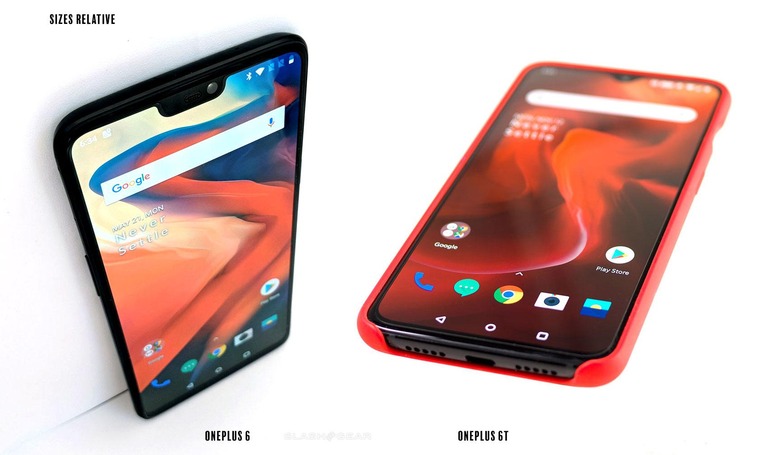
Both the 6 and 6T have a set of cameras on their back: 16MP with f/1.7 aperture and OIS and a 20MP camera used mainly for depth sensing, and both front-facing cameras are 16MP with f/2.0 aperture. Both devices are able to record the same size and speed videos both back and front. As you can imagine, both devices take photos and videos that are basically identical in quality.
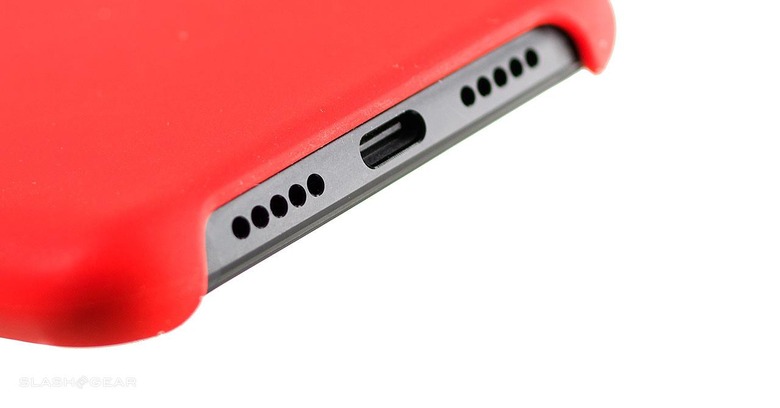
Both devices use the same processor and have the same amounts of RAM. While the OnePlus 6 has a 64GB internal storage size option alone with 128 and 256, the 6T only has the latter two options (larger sizes). The OnePlus 6 has a standard headphone jack, while the OnePlus 6T relies on its USB-C port and a dongle (included in the box).
The S6 has a bigger battery at 3,700mAh compared to the 6's 3300mAh. While the OnePlus 6T was launched with Android 9 Pie, the OnePlus 6 is already upgraded to said software. Both devices are water resistant, but not quite entirely waterproof.
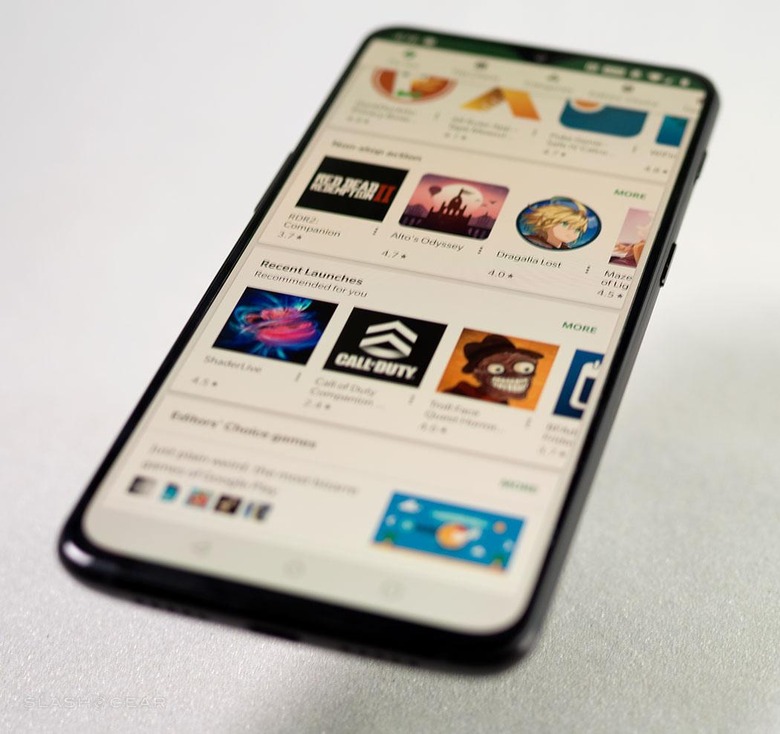
ABOVE: View from below the display. BELOW: View from above the display. Both are pretty similar – and there does not appear to be any severe loss of color/sharpness/etc at almost all angles.

The OnePlus 6 has a rear-mounted fingerprint scanner that is both fast and accurate. The OnePlus 6T has a front-facing fingerprint scanner that's accurate, but not extremely fast. Instead, the front-facing fingerprint scanner takes a moment or two (well under 2 seconds) to scan. This front-facing fingerprint scanner on the OnePlus 6T is discussed a bit more in the review below – take a peek!
As it is with most tick-tock phones, I'd still recommend you wait until next year to buy a new OnePlus phone – probably OnePlus 7. That's at least one year after you bought your last OnePlus device, 6 in this case. The differences between the OnePlus 6 and the OnePlus 6T are significant, but not nearly so significant as to justify a switch from one to the other.
Hardware
The OnePlus 6T has an interesting sort of front-facing display. Not only does it have a new shape, it has an in-display fingerprint scanner. The display gives little physical clues as to the location of the scanner when unprompted. Instead, you've got a piece of functional hardware completely hidden when not in use – as it should be.
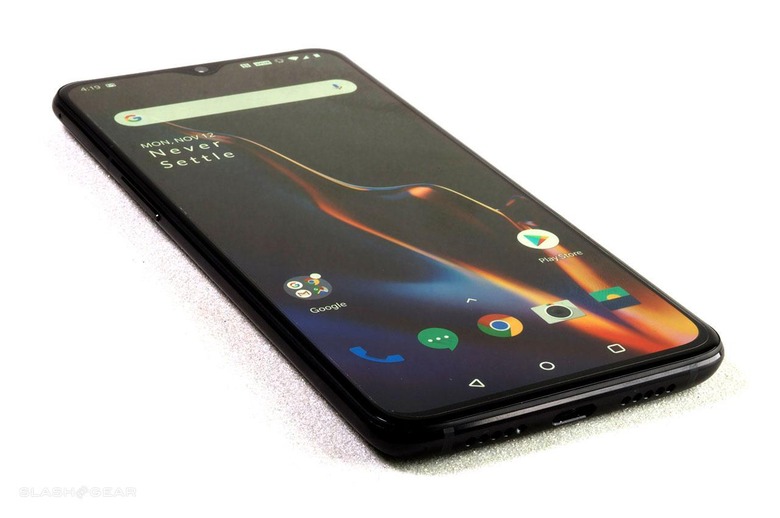
While this hidden hardware might also be the way things go for the invisible front-facing camera on all smartphones, for now we're still in the notch phase. Here we've got one of the least offensive notches in the entire notch universe – the waterdrop notch.

The true test of notches is in the pocket. I've had the OnePlus 6T and the Google Pixel 3 XL (world champion of substantial notches) in my pocket for the past half-week, and 9/10 times I reach for the OnePlus 6T. I reach for the OnePlus 6T because, even though the screen sizes are comparable, and the pixel density on the Pixel 3 XL is greater, the OnePlus 6T feels like less of a compromise. I also believe OnePlus handles the notch better than Google in some rather specific circumstances. More on that in the Software section below.

The cameras on this device are largely the same as they were with the OnePlus 6. In fact they're made with the same hardware, with just a bit of work done on software – but that's been brought to OnePlus 6 since the OnePlus 6T was released, too. Have a peek at the Camera section below to learn more.
The fingerprint scanner in this device is highly accurate.
Since it's not quite up on the surface (where other fingerprint scanners sit), it seems to scan and/or process a slight bit slower than the speed at which I'm used to seeing a fingerprint scan done. But it's still less than 2 seconds long, and I've never seen it open with a wrong finger, and I've never seen it fail with a correct finger – so it works!
Also it more than makes up for the time it takes to scan with an awesome green electric orb of spindly Borg lights. Of these lights and animation, I strongly approve.
Of the lack of a standard headphone jack on this device, I'm still not a super big fan.
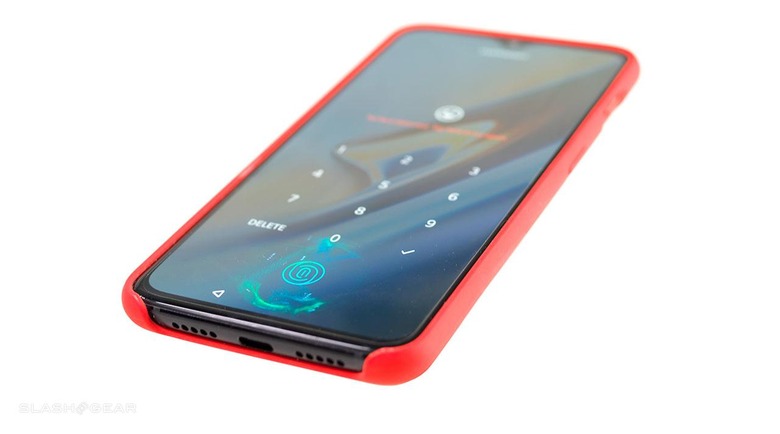
If you'd like to listen to audio with the $20 "OnePlus Type-C Bullets" you're more than welcome. These earbuds sound highly decent, especially for such a relatively low price. But the built-in DAC included with the headphones should, instead, be either in the OnePlus 6T itself or (at least) in the provided USB-C dongle.
One smartphone with no headphone jack and a USB-C that DID include some DAC action in their dongle is the Razer Phone – right out the gate. Then again, the Razer phone was and remains more expensive -unless you buy the first-gen device instead of Razer Phone 2, in which case you can find it for around $400, which is a steal.
My use-case for smartphone audio isn't entirely unique. When I listen to music in my vehicle, I use a standard AUX cord from the stereo system to whatever device I'm reviewing. When I listen to audio on the OnePlus 6T with the provided dongle, audio is difficult to manage.
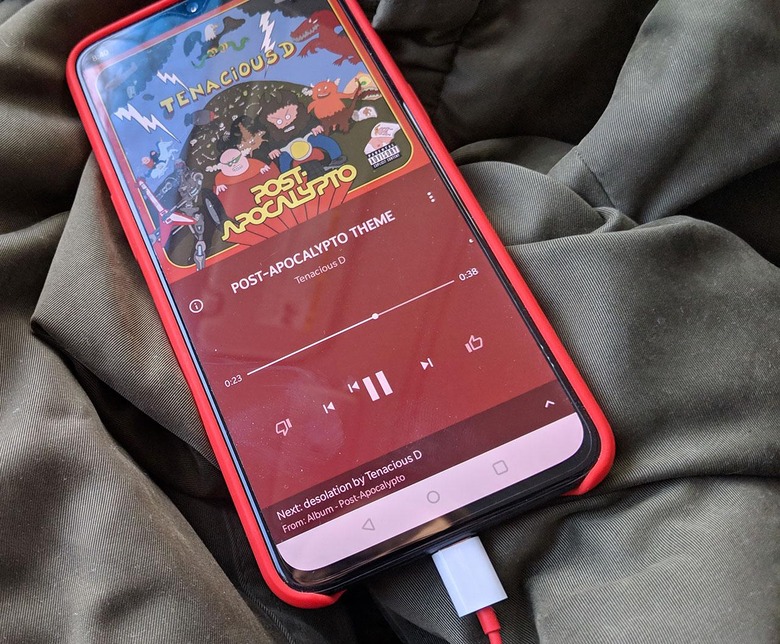
I listened to an album like the newest Tenacious D, an album with a lot of variety of sound – whispers, talking, yelling, acoustic guitar, heavy metal, and such. When I listened to this album with the OnePlus 6T with provided dongle, I needed to adjust the volume a significant amount – which, in turn, wasn't the case when I listened with an LG V35 (with built-in Hi-Fi Quad DAC). It was like night and day. Even listening with a OnePlus 6 was better – not perfect, but better.
Software
The OnePlus 6T has a software experience that isn't distractingly different from that of most other Android phones. They excel at allowing customizations for the home screens – with a quick and simple wallpaper changer, easy access to icon packs, and gestures. The most important thing OnePlus does – on all their phones, but here on the OnePlus 6T even more than any previous phone – is make a solid software experience.
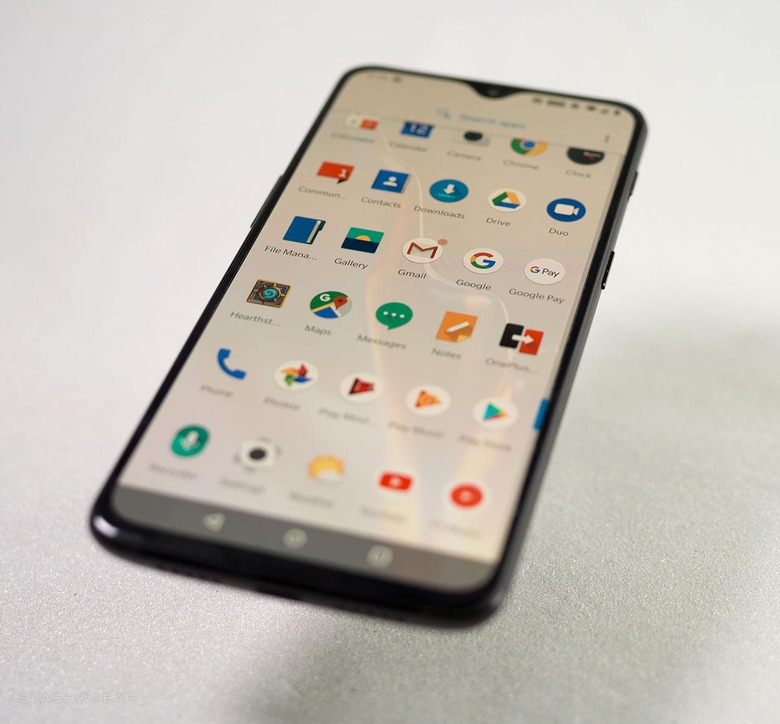
The part that's a bummer about owning a Google Pixel is Google's surprising lack of attention to broad app support. If we open the game Hearthstone on both the OnePlus 6T and the Google Pixel 3 XL, there's a difference we see immediately. While the OnePlus 6T accounts for the notch AND the design of their display (re: curved corners), the Google Pixel 3 XL does not.

You'll find that Hearthstone looks a bit odd on a Google Pixel 3 XL, what with curved corners on one side, and flat, rectangular corners on the other. I'd suggest that maybe this was because Blizzard hadn't yet optimized their game for all device display types, but look – OnePlus 6T does the job just fine.
It feels as though OnePlus found a near-perfect balance between running with their own brand power on top of Android and over-playing their hand. Samsung overplays their hand, regularly, when it comes to software they've made for their phones. Take Bixby, for example – you'll struggle to find a review of any of the last several Samsung phones in which Bixby is given a fully positive review.

And the Samsung software experience – it's less than optimal because they redirect users to their own Samsung app store. That'd be fine, but even their Android theme-specific store is full of less-than-great submissions and less-than-professional executions.
OnePlus, on the other hand, here with the OnePlus 6T, seems to know when it's best to use their own software, and when it's best to connect to Google Play. When you head in to the home screen customization area, for example, you'll find that the icon section has a little shopping bag – that leads to Google Play. It leads to a bunch of downloads that've been curated by Google.
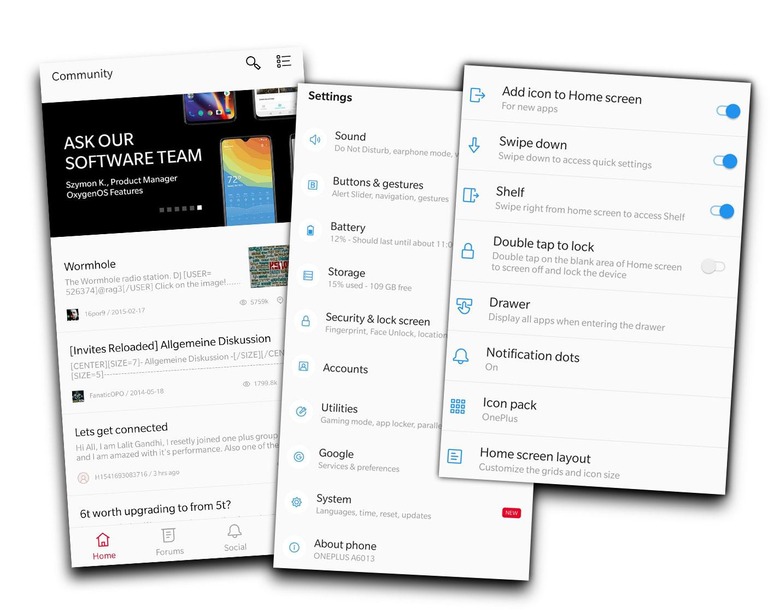
OnePlus has a phone data transfer app and a OnePlus Community app – an app in which OnePlus obviously takes a lot of pride in optimizing and keeping clean. This community is obviously curated somewhat, but even now, when I've just opened the app while writing this review, the top subject in the forum is a criticism of OnePlus. OnePlus allows this to be a place where OnePlus users speak freely – because it's the ideal place for OnePlus to get user feedback at no charge.
OnePlus also has a few other apps like a File Manager, Gallery, Audio Recorder, and their own arrangement of Settings. They've limited themselves to what they're able to do, and do well, it would seem. In the OnePlus 6T, the OnePlus developer crew created a great smartphone experience in the process.
Camera
The OnePlus 6T camera experience is largely what it was in the OnePlus 6 earlier this year. There's a new Night mode, but it's mostly just a longer exposure time – you've gotta make sure to hold your device STILL while using this mode, if you want any sort of positive result. The end result is OK, but not shockingly different from what a non-Night mode shot delivers.
Above you'll see a variety of photos captured with the back-facing camera on the OnePlus 6T. Note that this is a growing gallery. If you'd like us to capture any new photos in the near future, let us know the specific environment and subject matter, and we'll do our best!
Battery
I saw around a full day's use on this phone with mobile data from Verizon and my display brightness set to auto. Thanks in a large way to the power optimization of Android 9 Pie and the various OnePlus-made optimizations on the phone, it wasn't difficult to make it through a full day's work. Standby time on this phone – if you're not running a bunch of apps at all times – is incredible. Take a peek at the numbers in the screenshots below.

OnePlus has Adaptive Battery, Battery Optimization (per-app specific settings), and Battery Saver at your disposal – it's pretty crazy what you're able to do with regard to cutting back on functionality for the sake of extending your battery life. OnePlus 6T has its own charger – and OnePlus continues to push their own version of quick charging – but if you've used a OnePlus device before, your charger should probably do the trick fine if you happen to misplace the charger you get with this new OnePlus 6T.
Wrap-up
This phone is really nice. For a starting price of approximately $550 USD, it's incredible. I wasn't so sure about OnePlus moving from the midrange to the space between midrange and headliner phones – but they did it over the last year anyway – and they did it well. Now they're in a position that's strikingly difficult to beat, with a value in a smartphone that by all outward appearances seems to be near-impossible to beat.

But it doesn't have the best smartphone camera, and it still has a notch. And its silicone red case still isn't quite perfectly RED red, just nearly red, still a little bit orange. But beyond nitpicking, this phone is worth well above and beyond its price.
This phone is available in Mirror Black, Midnight Black, and Thunder Purple (as of November 15th). The Mirror Black version comes in two editions: 6GB RAM and 128GB internal storage for $549, or 8GB RAM and 128GB internal storage for $579. Midnight Black also comes in two editions: 8GB RAM and 128GB internal storage for $579 or 8GB RAM and 256GB internal storage for $629.

NOTE: You cannot yet get this phone on Amazon in the United States. Make certain when you're buying any OnePlus phone (or any phone, for that matter) that you've got the right name in the title: This is the OnePlus 6T with the T in there – even if the 6 seems to be the newest model, it's not. You'll need to go to OnePlus dot com to find the real deal – or T-Mobile USA, of course.

